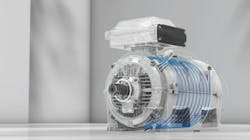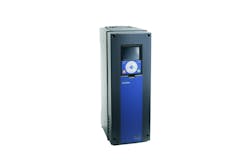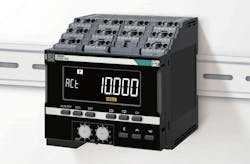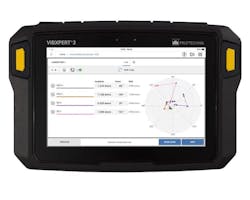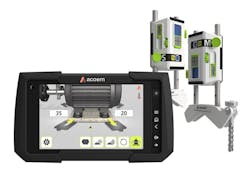Critical motors and motor-driven systems are ubiquitous in industrial environments. Technology providers are continually devising distinctive motor designs and advanced motor optimization solutions to increase uptime, efficiency, reliability, and performance.
Motor innovations
Fit-for-purpose motors solve unique application challenges. The CTV-3 & TVC-3 medium-high thrust vertical motors from Nidec/U.S. MOTORS are specifically engineered for use in vertical turbine pumping applications. The totally enclosed fan-cooled (TEFC) motor’s improved conduit box sealing and cast-iron frame, brackets, and fan cover guard all help to protect the motor during operation in severe-duty environments.
"This motor features through-the-bearing lubrication, which means it is better at expelling used grease. This is particularly critical for vertical motors, as it extends motor life," says John Frese, senior product manager at Nidec’s U.S. MOTORS Division.
Liquid-cooled SynRM motors recently introduced by ABB provide IE5 efficiency as well as a very high power density. Additionally, they can provide 100% torque starting from zero speed without a cooling fan. This innovative design minimizes noise and leaves the ambient air undisturbed, which is beneficial for different processes in food and beverage production, rubber, and plastic production, explains Ghanshyam Shrestha, R&D technology manager for ABB IEC Low Voltage Motors.
As an example, a “315 frame liquid cooled SynRM can provide 60% more power compared to the same size premium efficiency liquid-cooled induction motor. And it does this while still providing two classes higher efficiency,” notes Shrestha. “This all adds up to a cooler motor and bearings, smaller motor footprint, lower energy cost, and lower CO2 footprint.”
Optimization advancements
Monitoring the condition of motor systems is a reliability imperative. The VACON 100 and VACON NX drives from Danfoss are now embedded with condition-based monitoring capability. The intelligent drives can act as smart sensors, providing instantaneous insights into early issues in the motor and application, without a connection to the cloud or a PLC.
According to Kunal Shah, senior application engineer at Danfoss Drives, these intelligent drives enable regular checks of the condition and performance of the machine when the drive is in service, and detect mechanical, motor, or application failures in advance. Alarms/faults or warnings are triggered in the drive to notify customers or service technicians, and corrective actions can be performed before the process or application is impacted.
The new K7DD-PQ Series of remote advanced motor condition monitoring devices from Omron are designed to augment the productivity of existing maintenance resources and integrate motor condition monitoring into an IoT strategy, says Automation Engineer Jim Pankiewicz.
“The K7DD automates the data acquisition and analysis portion of motor condition monitoring. In addition, it can monitor the condition of motors that consistently change direction, such as servos, actuators, and valves,” observes Pankiewicz. “It has a learning feature that can learn the conditions of a failure if it’s able to be repeated. Lastly, it features failure mode templates designed to predict specific types of motor abnormalities when you’re looking to detect pump cavitation, cutting tool wear, or grease degradation along with many other conditions.”
The new VibXpert 3 Balancer from Pruftechnik, a Fluke Reliability company, is a smart device designed to help solve motor unbalance even in the toughest environments. It has six synchronous channels for measuring vibration levels from multiple angles at once. It supports resonance tests, phase measurements, and FFT spectrum data analyses.
“Unbalance is a leading cause of failure in rotating equipment and early signs are often missed by maintenance teams,” says Taylor Sheppard, field application specialist at Fluke Reliability. “Whether on the plant floor, in the field, or in harsh or extreme conditions, VibXpert 3 Balancer’s intuitive interface makes it easy for experts and non-experts to go straight to the root cause of the unbalance and correct it using step-by-step guidance.”
Avoiding misalignment in rotating machinery is the focus of the AT-400 shaft alignment system from Acoem. Its M9 and S9 dual-axis sensors are position-sensitive detectors with 0.001mm resolution. Seven unique measurement methods address diverse alignment challenges, such as Dual Sweep, which automates measurement recording during a sweep of the shafts. Other methods include Dual Sweep Express, Dual Multipoint, Dual Multipoint Express, Tripoint, Tripoint Express, and Clock.
GuideU is the AT-400’s patented, customizable 3D alignment graphical user interface that simplifies measuring, aligning, and reporting and minimizes errors. It uses icons, color coding, and animated help screens to guide the user through the entire process.
About the Author
Sheila Kennedy
CMRP & Owner – Additive Communications
Sheila Kennedy, CMRP, is a professional freelance writer specializing in industrial and technical topics. She established Additive Communications in 2003 to serve software, technology, and service providers in industries such as manufacturing and utilities, and became a contributing editor and Technology Toolbox columnist for Plant Services in 2004.
Prior to Additive Communications, she had 11 years of experience implementing industrial information systems. Kennedy earned her B.S. at Purdue University and her MBA at the University of Phoenix.
